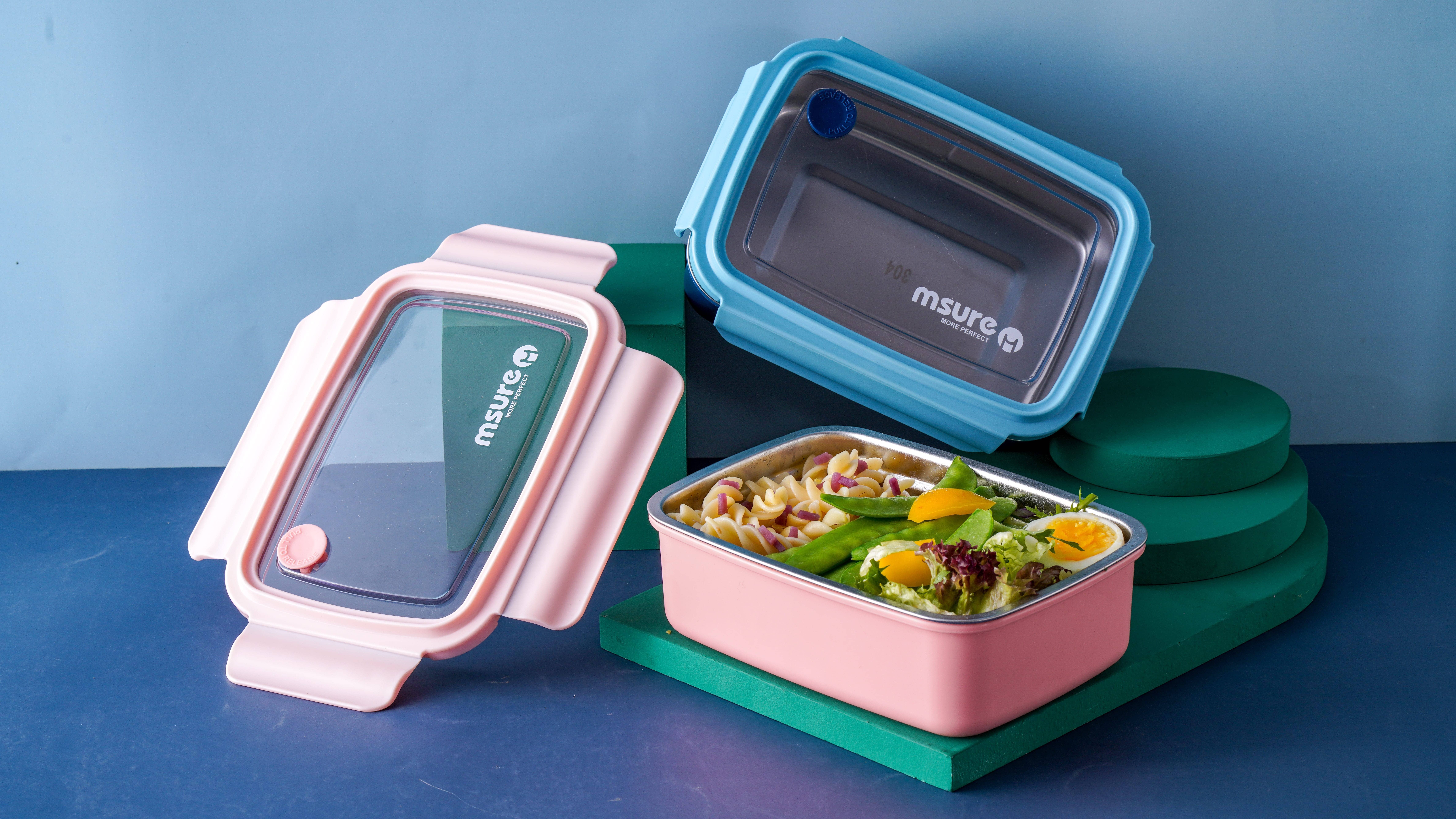We may receive a commission on purchases made from links.
One of the defining features of Japanese cuisine is its meticulously crafted, artistic presentations. The country is known for its kawaii bento box creations, often featuring adorable and edible animals or recognizable characters, and ornately-designed, luxurious sushi platters. No matter where you go in Japan, whether it's a cheap izakaya or a high-end ramen establishment, you'll likely be impressed by the attention to detail that goes into all the meals. And, that means selecting garnishes is just as important to Japanese chefs as perfecting the main ingredient. Stainless Steel Tiffin Box

Certain staple garnishes in the country are used to elevate a dish's appearance by bringing a unique texture or color to the meal, while also adding flavor. Shiso leaves frequently accompany sushi platters, edible flowers are great at adding pops of bright colors, and furikake is sprinkled over plenty of rice. But, Japan boasts another lesser-known garnish that we think should start making appearances in everyone's homemade bento boxes.
Sakura denbu is a commonly used condiment recognized for its show-stopping appearance. These dried, bright pink fish flakes have a fuzzy texture and a tasty sweet-and-salty flavor that can easily elevate just about any meal. While it's common to see these pink flakes sprinkled over steamed rice in children's meals, it can also make a more sophisticated pairing.
If you typically explore local Asian markets or wander through Japanese grocery stores, you may find yourself examining rather expensive pink packets filled with dried fish flakes. This popular Japanese condiment is known as sakura denbu, and it is usually made from boiled codfish. While it gets most of its flavor from that delicious white fish, it's also frequently flavored with ingredients such as sake, mirin, sugar, and salt. And, it wouldn't be noticeable without its unique texture and bright coloring.
While sakura denbu is a tasty seasoning that plenty of dishes benefit from, its most notable feature may just be its fun texture. Well-made sakura denbu is known for being fluffy, and similar in appearance to cotton candy. Even though they're technically fish flakes, the condiment is made in such a way that it becomes quite airy, making it an attention-grabbing garnish.
The first part of this condiment's name, sakura, means cherry blossom in Japanese. Like the beautiful trees that bloom in Japan in the spring, sakura denbu shows off a beautiful pink hue. This transforms it into a special addition to festive meals served in the springtime. While the coloring is entirely artificial, and it tastes the same without it, the color makes any dish all the more special.
Since sakura denbu derives from dried fish, it does have a salty flavor. However, since it is seasoned with mirin and sugar (among other things), it takes on a subtle sugary taste, as well. The striking sweet and savory flavors are balanced in sakura denbu, and it pairs well with other Asian condiments, like soy sauce.
While on a practical level sakura denbu is a delectable seasoning that plenty of dishes benefit from, it's just included in dishes for its bright pink coloring. But, it's good to note that the artificially added rosy color won't change the flavor of the fish flakes. Sakura denbu still tastes the same whether it's in its original white form or sporting the classic pink hue.
However, if you're trying to test out some of this one-of-a-kind Japanese condiment for yourself, it can be a bit difficult depending on where you're located.
Unfortunately, if you're located in North America, it may be rather tough to find this item in a regular grocery shop. While many big box stores feature an Asian product aisle with plenty of imported goods, sakura denbu is pretty hard to source. Instead, we recommend visiting a local Japanese grocery store or a nearby Asian market. If the store carries it, it will likely be with the dried or preserved foods section.
If you live in a small town with no Asian grocery store, purchasing the product online may be your best bet. Amazon and certain Japanese grocers, such as Hanamaru Japanese Mart, carry a few options online that can be delivered to your house.
However, with this ingredient being so elusive in the U.S., and sometimes quite expensive, it might be in your best interest to make your own sakura denbu at home. And, the process is likely much easier than you'd expect.
There are plenty of reasons you'll want to make your own sakura denbu at home. Whether you can't locate any packaged product near you, you're trying to save some money, or you'd like to avoid the preservatives in processed sakura denbu, making your own version is a great option.
Cod is the most commonly used fish for this dish, although plenty of other white fish species will work. The first step is boiling the chopped fish with seaweed or dashi. The cooked fish is then removed from the water, drained, rung out to get rid of any extra moisture, and shredded.
The flaky fish then gets added into a pot with additional ingredients. Typically, sugar, mirin, salt, and sake are used to give the fish its classic flavor. When vigorously mixed around with chopsticks, the cod will eventually congeal into an airy and fibrous ball of fish flakes. At this point, these flakes are ready to be dried out and used, but if you want them to showcase their iconic pink hue, use a red food coloring. Experimenting with different natural ingredients (such as beets or red cabbage) to achieve this effect is fine, but regular food coloring from the store is the simpler option.
Once the sakura denbu is ready, there are endless recipes you can experiment with whipping up. And, it's not limited just to garnishing bento box sushi.
Sakura denbu's sweet and salty taste complements lots of Japanese dishes. It can be featured in different side dishes or entrées, making them more festive and vibrant. It's an especially good addition during cherry blossom season, when the flower's pale pink color appears everywhere in Japan.
Sakura denbu is most commonly used to decorate rice inside kids' bento boxes. Often, these boxes feature cute characters or edible designs made from colorful ingredients. When mixed with white rice balls, onigiri, or other rice meals, the pink coloring comes through nicely. It can be used to dye a variety of designs, such as a family of pigs, hearts for Valentine's Day, or flowers fittingly resembling a cherry blossom. It can also just be placed on top of the rice grains, showing off its fluffy texture.
Similarly, sakura denbu can be rolled into sushi rolls, allowing the cross-section to display plenty of eye-catching characteristics.
Sakura denbu is truly a versatile ingredient, and it can likely be used in any creative way you dream up. And, this garnish not only looks and tastes good, but it's also relatively healthy, at least when it comes to condiments.
Since sakura denbu is mostly just used as a garnish, you will probably never eat large amounts of the stuff. So, you don't have to worry too much about whether or not this food is nutritious. That being said, sakura denbu is relatively healthy, at least as it pertains to condiments.
As you know, sakura denbu is made from cod fish. Cod is a popular option for the more health-conscious, as it is lower in fat than other favored species, like salmon. It also is loaded with protein, along with important vitamins and minerals.
However, with the added salt and sugar in sakura denbu, it's not something you should be consuming huge portions of by any means. But, it's perfectly fine to pair with rice, fish, and whatever else you prefer for dinner.

Black Lunch Box So, whether you try sakura denbu out for yourself as part of a creative homemade bento box meal or you choose to order a dish made with it the next time you're out at a Japanese restaurant, we think you'll enjoy the fun springtime energy this garnish brings to any dish.